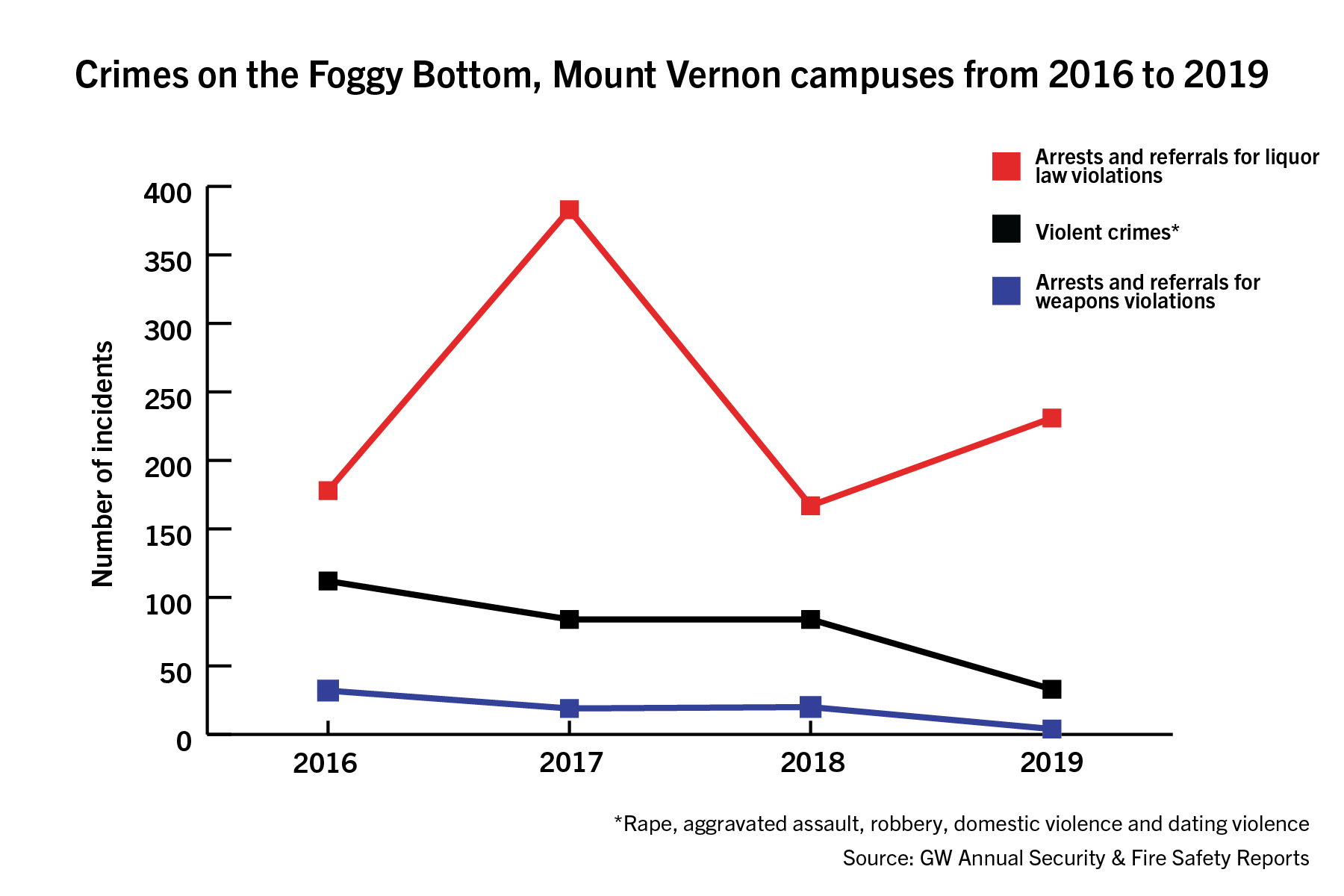Violent crimes on campus declined for the third straight year in 2019, according to the Annual Security and Fire Safety Report released last month.
Officials recorded 31 violent crimes – which include robbery, aggravated assault, rape, domestic violence and dating violence – on the Foggy Bottom and Mount Vernon campuses in 2019, 23 fewer than in 2018. Officials credited the drop to safety initiatives in the city, adding that they’ve since increased staff in the Office of Advocacy and Support and released an enhanced campus safety app with expanded crime reporting features and resources to help drive down violence on campus moving forward.
The 2019 report indicated a surge in liquor law violations, with 230 in 2019, up from 165 violations in 2018. Officials credited that decline to a laxer liquor law policy that eased restrictions, stipulating disciplinary measures only for students directly involved in underage drinking instead of all who are present at an incident.

Sidney Lee | Graphics Editor
Of the 31 violent crimes officials filed in 2019, there were 19 rapes, five cases of domestic violence, four cases of dating violence, three robberies and no aggravated assaults. Cases of dating violence were the only category to report more incidents in 2019 than in 2018, when GW’s Annual Security and Fire Safety Report showed one case of dating violence.
Richard Goldschein, the senior compliance associate for the Division of Safety and Facilities, attributed the downward trend to safety initiatives launched by the District government and University. He said the relative safety of college campuses compared to surrounding areas in general also helped maintain security.
“The University continues to emphasize safety as the No. 1 service priority, and we continue to make enhancements in our security-related capabilities such as access control and emergency notifications,” he said in an email. “Over time, these continued investments build a culture of preparedness and should help reduce overall crime on campus.”
Goldschein said violent crimes like domestic violence, dating assaults and rape are often underreported nationally. He said officials tripled the size of the Office of Advocacy and Support and created a space for survivors to receive “confidential support and prevention programming” on campus at 520 22nd St. in 2020 following the reporting period for the 2019 report to capture every incident possible.
“While we do not necessarily want our numbers to rise in those categories, we want survivors to feel comfortable reporting these incidents and get connected to important resources,” he said.
Goldschein said the report’s release, typically scheduled for October, was delayed until December following U.S. Department of Education’s decision to extend the deadline for universities to submit their reports in response to the COVID-19 pandemic.
Scott Burnotes, the vice president for the Division of Safety and Facilities, said the department hired Goldschein and partnered with the Clery Center, a nonprofit promoting campus safety, last year to accurately report crime data for the report. Burnotes said he urges students to read the report and use safety measures like the GW Guardian app, introduced this fall, to improve GW’s census of crimes.
“We are committed to accurately reporting the crime statistics as required by the Clery Act, but the process truly starts with the participation of our campus community,” he said in an email.
Criminal justice experts attributed the decline in violent crime to increased access to crime reporting and tighter campus security measures – part of a nationwide trend of declining crime rates and enhanced safety on college campuses.
Violent crimes regress as weapons violations plummet
Violent crimes, which include rape, aggravated assault, robbery, domestic violence and dating violence, have dropped by more than 72 percent on campus since 2016. Administrators counted 31 violent crimes in 2019, compared to 54 in 2018 and 82 the prior year.
Among these crimes, rapes and robberies have seen the sharpest declines. Reported rapes dropped by more than 50 percent since 2017, falling from 39 to 19, while robberies dropped from 10 in 2018 to three in 2019.
John Sloan, a professor emeritus of criminal justice at the University of Alabama, said GW’s declining trend contrasts with increasing violence rates across D.C., where 200 homicides marked a 16-year high in 2020. He added that college campuses across the country are considered relatively safer than surrounding areas.
Sloan said a critical preventative measure against violent crimes on college campuses starts at freshman orientation, where students can be informed about potential dangers, methods of reporting and consequences of violations. During virtual orientation last year, officials rolled out GW Guardian, a campus safety app that offers students access to resources like domestic violence and suicide hotlines, the Title IX office, campus advisories and SafeRide.
“I don’t want to call it security training, but information about being aware of your surroundings and being in groups can help raise awareness,” Sloan said.
Disciplinary referrals for carrying or possessing weapons plunged from 14 in 2017 and 13 in 2018 to just one in 2019. Officials filed just one weapons-related arrest in 2019, compared to three in 2018, according to the report.
Goldschein, the DSF senior compliance associate, said the federal education department issued a reporting clarification for the 2019 report, stating officials only needed to file disciplinary referrals for weapons that violated D.C. law as opposed to University policy, driving the sharp decrease in referrals.
University policy states that all students are prohibited from possessing firearms, while D.C. law permits concealed carry.
Liquor law violations surge
GWPD filed 230 liquor law violations in 2019 after recording only 165 in 2018, marking a nearly 40 percent jump in alcohol-related disciplinary referrals. The increase reverses a short decline in referrals, which shot down from 373 in 2017, when officials say they loosened their disciplinary policy to only cite students directly responsible for underage drinking.
Goldschein said the number of liquor law violations increased because disciplinary referrals for those violations are counted per person rather than per incident. He said there were five incidents in Foggy Bottom in 2019 when 10 or more people received referrals, accounting for nearly 30 percent of the campus’ annual referral total.
He added that 75 percent of yearly referrals on the Vern in 2019 occurred at just two incidents.
Sloan, the Alabama emeritus professor, said universities should take a holistic approach toward confronting liquor law violations, taking into account factors like peer and social pressure, rather than “not really dealing with the problem.”
The University requires all first and second-year students to complete an alcohol education course, where they learn about alcohol abuse and sexual assault prevention.
“A lot of violations have to do with figuring out ‘How am I going to fit in here?’” he said. “So when you come onboard, you’re new, you’re trying to understand the dynamic, you’re trying to make new friends. To some degree, your guard is lowered.”
With more freshmen completing an online orientation this year owing to the pandemic, he said universities may have to make these programs more interactive through group activities rather than independent online courses to maintain the quality of the programming and reduce the number of violations once students return to campus.
Matt Nobles, a professor of criminal justice at the University of Central Florida, said the University’s 2018 policy changes, which eased back on alcohol-related punishments, could have led individuals to become more lax in following guidelines, knowing that referrals would only be made to those directly involved with underage drinking. He said universities should focus on encouraging students in Greek life, where cases are concentrated, to drink responsibly to cut down on the issue.
“Many of the behavioral complaints and chronic issues with alcohol and substance abuse tend to be associated with the Greek apparatus,” Nobles said.








